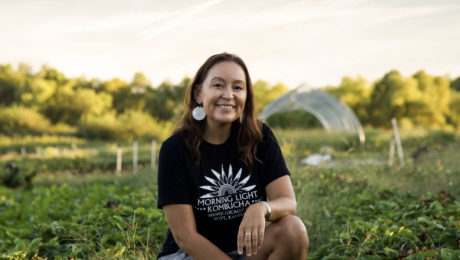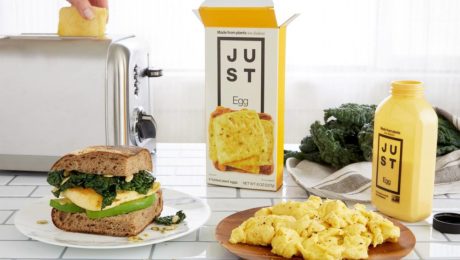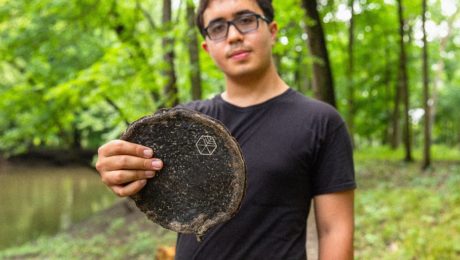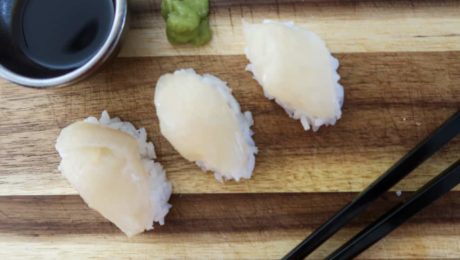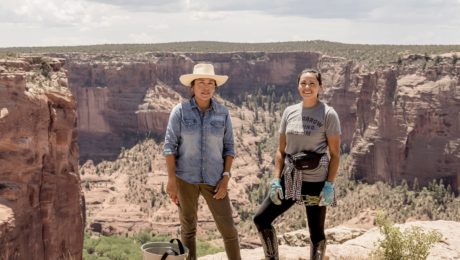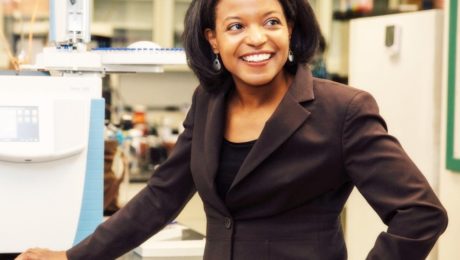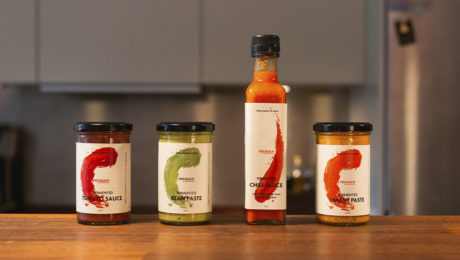Q&A: Melinda Williamson, Morning Light Kombucha
Melinda Williamson has always been fascinated by plants — she grew up watching her mother make baby food with produce from the garden, later studied medicinal plants in college and dedicated her career as an ecologist to researching microbial communities in soil.
So, when Williamson became extremely sick with an autoimmune disease eleven years ago, it was not surprising that she turned to plants. She began making green smoothies daily and, after a student shared a bottle of it with her, drinking kombucha.
“I became really conscious about what I was putting in my body, really focusing on where my food was coming from,” says Williamson, founder of Morning Light Kombucha in Hoyt, Kansas. “I started researching my illness, and found that a lot of stuff stems from the gut. It brought me into this world of ferments.”
The health-scare-turned-health-revival changed the course of her life. Mother of a then-young child, Williamson moved back to Kansas to raise her daughter closer to family. She took a language program job on the Prairie Band Potawatomi Nation reservation in her hometown, then spent her hours off work fulfilling a dream of running her own business. She perfected a home-brewed kombucha and began selling it at local farmers markets, gas stations and yoga studios.
The pandemic easily could have shuttered a small brewery like Morning Light which, prior to 2020, Williamson ran on her own. But she designed a website, opened an online store, started curbside delivery and launched a canned line — and sales grew by 25%. By the end of 2021, Morning Light Kombucha will start shipping nationally and, by the end of next year, they plan to break ground on a 4,000-square-foot facility on the reservation.
“What I really want to do is get my product into more native communities, so they can find healing just like I found healing,” says Williamson, head of the only Native American kombucha brand. “That’s more important to me than seeing my product on the shelf of Wal-Mart or Target. I’m not in it to be rich. I still plan on living in my little house here on the reservation close to my family. I just want to do something that has meaning and an impact.”
Below is an edited Q&A between Williamson and The Fermentation Association.
TFA: Where do you get your ingredients? You forage some of the ingredients yourself on the reservation.
MW: We go out and harvest wild blackberries, wild raspberries, chokecherries and pawpaws mostly on the reservation. There’s edible plants everywhere, it’s surprising the places you can find them. We just went to Overland Park, which is the city near us, to forage for pawpaws.
Some of the ingredients like gooseberries, those we find in small quantities. If we go out and we only get four cups of berries, we may not make any kombucha with it. But sometimes I’ll make a little five gallon batch.
Most of our ingredients, we partner with local farms in Northeast Kansas. It comes down to the importance of knowing where our food comes from. My goal was to always work with local farmers and source ingredients locally, I knew I wanted that as part of my business foundational value.
As much as possible, we keep sustainability at the forefront of everything that we do, being really conscious about our footprint. It’s really nice because, being in Northeast Kansas, people aren’t thinking about stuff like that. They’re more and more thinking about where their food comes from, but it’s been really nice to have those conversations with the community and get people really thinking about supporting the local farming economy, supporting local business.
A big part of it really comes down to what we’re showing our kids. Before my daughter was born, I had her when I was 23, I was eating a lot of fast food. I was like “I’m free! I’ve got a job! I can buy and eat whatever I want!” I was eating so much junk food. And then I got pregnant and wanted to feed her properly. I grew my own garden and started making my own baby food, just like my mom modeled for me. Food is so important, it’s a constant conversation in my life and in my business.
TFA: Do you make seasonal flavors then?
MW: We launched our canned kombucha line in February. Prior to that, we were doing about 100 flavors a year, so now that we’ve launched our canned kombucha line, we’ve had to whittle that down because we have to have four flavors constantly. Our rotations have diminished a little, but we’re still putting out about 60 flavors a year.
Our berry flavors are our most popular — blackberry lemongrass and strawberry. Seasonally, our smaller batches that people love are mulberry, that is a top seller. People also love the ginger and chokecherry flavors.
TFA: How do you sell your small batches? Are you selling them retail or filling kegs on site?
MW: We sell direct-to-consumer, like at the farmers markets and events. We don’t have a brewery that’s open to the public. We do curbside pickup, that was something that was developed in response to the pandemic. We could no longer sell directly to the consumer, so we just started doing doorstep delivery, then the curbside pickup. Basically, people just have their empty bottles in their trunk and call us and we come out and grab their bottles, and swap them for new, filled bottles. It’s contactless, but we still got to see our customer and wave. We’ll probably continue to do that, we’re still in this pandemic, and the most important thing is to keep our community safe and our elders up here safe. We will continue taking all precautions to protect people around us until we hit a safe spot.
TFA: A portion of your sales goes back to the native communities. Tell me about that.
MW: We donate where we feel like the money would be used best, things that we’re passionate about and things where we see we can make a difference. For example, we just recently donated to one of the residential school survivor nonprofits. We’ve taken clothes to Standing Rock Sioux Tribe where they were protesting the Dakota Access Pipeline, we’ve donated to our Boys and Girls Club here on the reservation, we’ve donated to our youth soccer teams, we’ve donated to First Nations programs in Canada.
TFA: Morning Light Kombucha is a trademark American Indian Food product. What does that mean?
MW: So that trademark American Indian Food falls under the Inter-Tribal Agricultural Council, which is a subset under the USDA. The program really highlights American Indian food producers. You apply and then the program supports you in different ways. We’re able to network with other American Indian food producers, brainstorm together and talk about what we’re experiencing and try to make movements when it comes to distribution. The program is really big with international exporting, so all the American Indian food producers have the opportunity to attend large trade shows internationally, they’ll fly us there, ship our products and give us the opportunity to have a booth and get our product in front of people who are interested in American Indian food products. I’m not ready for something that big, I am so small, but I’ve gone to a domestic show through the program. I went to a food show in Chicago and got in front of a lot of people who are interested in my kombucha. We have really big plans in 2022 to expand our facilities, and hopefully expand domestically.
TFA: What are Morning Light Kombucha’s plans for 2022?
MW: I just bought 10 acres here on our reservation. My plan is to break ground and build a production facility. It will be three times the size of what we’re in now, which will be really, really nice. There’s a pond on the side, we’ve got a creek, timber, a lot of foraging areas. The plan is to build an off-the-grid brewery, too, so it will help us provide more jobs in our community and it will allow us to do some of the things that we haven’t been able to do.
I mentioned sustainability is a big part of what we do. We compost 100% of our brewery waste, but I have to truck it to my house to my compost pile because, where we’re at now, we just can’t compost large quantities at our site. The waste water from our water filtration system, it’s totally usable water, but we don’t have any place to store it currently. Our waste water is not like gray water, it’s clean water that’s just wasted during the filtration process, it’s usable. For every one gallon that’s filtered, there’s three gallons that’s wasted. It’s so insane, it killed me when I found that out. Once we are in our new facility we can begin to recycle it on property. We have this dry pond. Our plan is to see if we can get it lined, divert the waste water in there and start filling the pond.
TFA: Scaling will be big for you in 2022.
MW: I know, I just hired three employees recently because it’s just been me for the past few years. I work part-time for our language department, and my kombucha business has been my side hustle. In the past year, I’ve realized the potential. People really like my brand and they’re noticing it and requesting it. So I thought “Maybe I could grow this brand into something bigger.”
TFA: I am beyond impressed — you have been building a kombucha brand by yourself?!
MW: Family is always there for me. My boyfriend is at the market, my nephews help with anything I need, it’s a family affair even though I never really had anybody on my payroll until recently. Now I’m getting to a point where I need help all the time. I hired my sister as my brewery manager, she keeps a tight ship. It’s allowed for me to really work on expansion while she’s running operations at the brewery.
TFA: Yours is still the only Native American-owned kombucha brand.
MW: With my business, I like to think that I’m also giving a voice to native issues. I would never want to be an authority on native issues, but there’s a lot of things going on in Indian country that people don’t see in the mainstream media and mainstream social media. If I can build a brand that can also bring awareness to these things, that’s really important to me.
TFA: You have a background in academia. What got you interested in ecology before switching to kombucha?
MW: I’ve always loved science, I’ve always loved the outdoors, I’ve always been super eco-friendly, I’ve always been conscious about our impact on the earth. I love animals, I love nature. I was taking some of my general ed classes at Haskell (Indian Nations University) and took an ethnobiology class. I just fell in love. I ended up transferring to Kansas State and got my degree in environmental biology (then a masters degree in rangeland ecology and management from Oklahoma State University.) I went with my boss from K State to Oklahoma State and ran the grassland ecology lab for years.
TFA: Where do you see the future of fermentation?
MW: There’s an explosion. I see it continuing to grow and expand and people are coming out with really innovative ways to bring fermentation to the table. Like Wild Alive Ferments out of Lawrence, Kansas. We’re a part of a local CSA with them. The owners just came out with an apple kraut flavor, an autumn harvest with spices that is so amazing.
In the U.S. especially, we have a lot of people who are sick with illnesses or cancers and autoimmune issues and I think we’re starting to see more people look at what they’re putting in their bodies. They’re realizing the importance of gut health, the importance of ferments, and that it affects so much more than just your gut. It’s a movement — and I’m really excited about it.
- Published in Business, Food & Flavor, Health
How Can Brands Educate Consumers on Alt Protein?
Alternative protein companies need to stop advertising their brand as the most ethical choice and instead appeal to consumer’s taste buds.
“Sometimes plant-based food companies don’t really market themselves as food,” says Thomas Rossmeissl, head of global marketing for Eat Just, Inc., which develops plant-based “eggs” and cell-cultivated meat. “There’s this inclination to talk about mission. We say ‘We’re good for the planet,’ ‘It’s good for you,’ ‘It’s good for animals’ and obviously that’s all true and it’s admirable and it’s what drives me in our company. But it can come off like we’re sort of apologizing, that we’re negotiating with consumers, that a consumer is sacrificing something delicious to get something ethical or healthy.”
“People not buying (traditional)meat and cheese because an animal was killed or tortured. They buy because it tastes great.”
Irina Gerry concurs. Gerry is the chief marketing officer for Change Foods, an animal-free dairy brand that will launch their product in 2023. Alternative protein brands need to “flip the script from plant-based, rationalizing the food choices.” Brands need to help consumers feel that purchasing an alternative protein is a “natural choice rather than a sacrifice.”
The two spoke on a panel Insights on Consumer Perceptions of Alternative Proteins at the virtual Good Food Conference. The conference is put on by the Good Food Institute, an international nonprofit that promotes plant- and cell-based meat.
Wide Consumer Base Wanting Animal-Free
Animal-free is the main driver for customers to buy alternative products. The alternative protein industry is not just marketing to vegans, they’re also selling to flexitarians and omnivores concerned about welfare. Ninety-four percent of Eat Just consumers consume some type of animal protein.
“Sustainability is skyrocketing and potentially could cross over health as the main motivator, especially in the younger population,” Gerry says.
The modern American household family fridge is divided. There may be three types of eggs in there — conventional, cage-free and plant-based — and three types of milk — dairy milk, almond and oat. Consumers as young as 12 are the ones educating themselves on alternative proteins.
“We’re going to see this younger generation drive families to plant-based solutions,” Rossmeissl says.
Staying Honest, Maintaining Trust
Transparency will be central to public adoption. Laura Reiley, a reporter for The Washington Post who moderated the panel, noted “there hasn’t been tremendous transparency” with the alt protein market. She’s written about the market since its beginning and notes, because there’s intellectual property and so much research and development dollars, most companies have kept their food shrouded in mystery.
“We don’t want to sort of follow the example of the conventional industry. We can do better than that,” Rossmeissl says. “On the cultivated side, we have a huge responsibility to get this right. Not just as a company but as an industry, we can’t screw this up.”
Perceived unnaturalness by consumers of alt protein is a challenge. Using the term lab-grown “is disparaging to us as an industry” he continues, “but I think the best way we can address that is by being really honest and what’s in it and how it’s made.”
Gerry notes 90% of dairy cheese sold globally is made with non-animal remnants through precision fermentation — and that’s been the predominant way traditional cheese is made for over 20 years. It’s the same technology Change Food’s animal-free cheese uses.
“(These traditional cheeses) made through precision fermentation, they’re labeled under natural and oftentimes organic cheese products and nobody’s grown a third leg and nobody’s freaked out, right?” Gerry continues. “But now we’ve added one more element of that cheese — removing the cow from the cheese — and everybody seems to be greatly concerned.”
The Forefront of Alt-Proteins in Africa
Price and regulation are big roadblocks for alternative proteins, an industry that is expanding rapidly, as more consumers turn to animal-free products out of concern for their health, the environment and animal welfare.
“People love meat but, at the end of the day, they’re not really attached to how it got to their plates,” says Brett Thompson, co-founder and CEO of Mzansi Meat, a cultivated meat company in South Africa. Thompson spoke at the TFA webinar The Forefront of Alt-Proteins in Africa with another leader in the South African alternative protein industry, Leah Bessa, PhD, co-founder and CSO of De Novo Dairy.
Alt-protein companies all over the world are bringing cultivated meat and dairy to consumers, but Africa as a continent has lagged.. Thompson founded Mzansi Meat Co. in 2020 and hopes to bring cell-cultured beef, chicken and braai sausages (traditional South African BBQ-style sausages) to retail shelves next year. De Novo Dairy, formed in 2021, is using precision fermentation to create milk proteins for animal-free dairy products, but without cows.
This novel biotechnology is new in South Africa, but it’s a critical element in addressing food security problems in Africa. Africans don’t consume enough food, especially protein, and as drought continues to plague the continent, raising animals for traditional meat products is becoming less and less sustainable.
“It’s a very different conversation to the rest of the world,” Thompson adds. “It’s about getting more protein into more people’s stomachs and plates.”
Big Production Costs in New Alt-Protein Space
Interest is high from investors, but scaling from pilot stage to large-scale production is challenging. Equipment is costly and labor is difficult to recruit to a new industry.
In a survey conducted by Mzansi, 50% of South Africans were willing to purchase alternative protein products — and they’d pay a higher price than for traditional meat.
“But we just got to make it available,” Thompson says. “That’s going to be the biggest hurdle for us, getting it into retail and getting it in front of people so that they can make that decision.”
Bessa says that, critical to the adoption of animal-free dairy, the consumer must receive “nature identical” products. These must replicate the taste, texture and nutrition level of traditional dairy — and precision fermentation is a “powerful tool” to helping achieve that goal.
“It’s going to be a very easy sell,” Bessa adds. “What’s really great about precision fermentation is, as a technology, it’s not limited to just one or two proteins. You can really explore other functional elements and other functional proteins across the food industry. So we’re really looking beyond just dairy, but we want to solve a big problem in the dairy industry because it’s very unsustainable.”
The Good, the Bad & the Ugly — of Government Regulation
Bessa notes regulation is a bigger challenge than technology for De Novo. Three governmental bodies in Africa oversee food production — the departments of trade, health and agriculture. Mzansi is exploring launching in food service, as an alternative to the long, arduous process of securing government approval to sell a product at retail.
“Consumers want something that’s familiar but, now with regulatory hurdles, if you have to classify and label them differently, then how familiar would that label be to consumers?” says Josephine Wee, assistant professor of food science at Penn State University (and a TFA Advisory Board member). Wee moderated the discussion with Thompson and Bessa. “I think it’s an important conversation as well because it might be confusing if it tastes just like milk but is labeled completely different.”
Transparency is a priority for both Mzansi and De Novo. Thompson says companies preaching sustainability can’t be “cagey…or you send out messages that are convoluted.” Bessa agrees, noting a young company may never recover from bad publicity over transparency issues.
“Working with new technologies, especially in food, which is such a personal thing for people, you almost want to get ahead of assumptions, you want to be the one putting out the information and the correct information,” Bessa says. “That’s why it’s so important because you’re working with a novel technology, you’re feeding people with this novel technology, and so it’s important to be transparent so that they feel comfortable and they can relate to what they’re consuming.”
- Published in Business, Food & Flavor
Wood Alternative from Kombucha Waste
A new wood alternative made from a byproduct of kombucha brewing waste won this year’s James Dyson Award, which celebrates problem-solving design. The material, called Pyrus, was invented by sustainable-design student Gabe Tavas. Tavas’ company, Symmetry, makes small items from Pyrus that replicate exotic woods like mahogany or purpleheart (two wood types found in the rainforest and endangered by aggressive deforestation).
Tavas was inspired to create Pyrus after seeing designers use kombucha bacterial cellulose (the film that grows on top of the beverage during brewing) in various projects. Tavas was struck by the fact that trees are made from cellulose, and he began experimenting in his dorm room with the waste from his own kombucha brewing. He eventually partnered with local Chicago producer, KombuchAde, which supplies Tavas with 250 pounds of cellulose a day.
Pyrus is made by pouring cellulose into a mold, adding agar (an algae-based binding gel), and then dehydrating and compressing it. The synthetic wood can be sanded and cut, but will decompose in contact with water.
Read more (Fast Company)
Alt Fish Protein Launch
A female-led food startup is the first in the world to develop a whole-muscle cut of alternative seafood “meat.” Aqua Cultured Foods, based in Chicago, uses biomass fermentation technology to produce alternative fish products, like filets of tuna and white fish, calamari and shrimp.
The company makes seafood analogs using a proprietary strain of fungi. Vegconomist describes their microbial fermentation process as “growing” protein rather than food processing of a plant-based product. Fermentation allows Aqua Cultured Foods to mimic the taste, texture and nutrients of fish.
“Biomass fermentation delivers a whole, unprocessed seafood alternative that is very different from plant-based seafoods available today. We can adjust the production conditions and inputs to create a different texture, shape, or nutritional profile,” says Anne Palermo, CEO & Co-Founder of Aqua Cultured Foods. “The excitement around these products is coming from several sectors, including restaurant and foodservice as well as fresh refrigerated set for grocery. In the same way some vegan products are now featured in the meat department, ours can be sold alongside animal-based fish at the seafood counter.”
Read more (Vegconomist)
- Published in Food & Flavor
Native American Brewery with Traditional Flavors
Bow & Arrow Brewing in New Mexico is part of two small but growing groups in the U.S. — it is both female- and Native American-owned.
Bow & Arrow locally sources their traditional Native American ingredients (blue corn, Navajo tea, three-leaf sumac) for their seasonal sour beers. The hops they use — subspecies neomexicanus — were used for their antiviral properties by the Navajo people in the Southwest,who put them in teas and salves. The brewery owners — Missy Begay and Shyla Sheppard — forage for hops in the mountains near Albuquerque. They also give their spent brewing grains to a local Native American family for use as feed for their livestock.
Begay, pictured left (who is Diné [Navajo]) and Sheppard, pictured right (a member of the Three Affiliated Tribes [Mandan, Hidatsa, and Arikara]) met at Stanford University in 2000. They took different career paths, but both fell in love with craft beer and homebrewing. They opened Bow & Arrow Brewing Co. in 2016.
“There is a sweetness to the land here, and all of this is sacred. We hope, as Native American women brewery owners, that people understand the story we have to tell,” Begay says.
Read more (Outside)
- Published in Business, Food & Flavor
Fermented Fungi Forge Forward
The alternative protein industry continues to explode in growth — and fermented mushrooms are leading the pack as the preferred meatless protein. In a recent article, the World Economic Forum highlighted mycoprotein, the protein-rich, flavorless “foodstuff” made from fermenting mushrooms. Companies creating alt proteins with fungi “are starting to sprout almost overnight,” the article notes.
Mycoprotein has a big advantage over plant-based proteins, as it has a meat-like texture that can then be flavored to taste like animal meat. Plant proteins must go through further processing to replicate a meat-like texture, and many plant proteins retain the taste of the original plant.
The mycoprotein production process was developed and patented by UK brand Quorn in 1985. But their patent expired in 2010, and the food technology is now available for all.
Read more (World Economic Forum)
- Published in Business, Food & Flavor, Science
The State of the Art in Coffee Fermentation
More specialty coffee producers are developing unique approaches to their coffee bean fermentation, isolating native microorganisms to create a flavorful cup or working closely with rural farmers to utilize fermentation control techniques on small-scale operations.
“Practically all the coffee we drink has been fermented in one way or another. But there is huge room for improvement, innovation and development in the realm of coffee fermentation,” says Mario Fernández, PhD, Technical Officer with the Specialty Coffee Association (SCA). The SCA partnered with The Fermentation Association for the webinar The State of the Art in Coffee Fermentation.
Fernández continues: “Coffee is produced by millions of small coffee producers around the tropics that have very little capital to invest in fermentation equipment. Oftentimes, the price is too low for them to add fermentation controls as part of the cost equation. Therefore, for perhaps 99.9% of coffee in the world, it undergoes wild fermentation, in which the microbes grow on the mass of mucilage in a wild fashion and the coffee producer only controls certain parameters, such as the length of the fermentation.”
Two industry experts on the forefront of coffee fermentation technique and technology joined Fernández — Felipe Ospina, CEO of Colors of Nature Group (multinational specialty coffee trader) and Rubén Sorto, CEO of BioFortune Group (a coffee, upcycled and food ingredient manufacturer based in Honduras).
Post Harvest Processing Technology
Sorto is adapting fermentation technology to coffee, mapping the microbiota of the bacteria and yeasts that are present at Biofortune Group’s farms.
“We realized that fermentation was one of the key aspects of the coffee production that hadn’t been addressed,” Sorto said, noting fermentation is controlled in industries like dairy, wine, beer and bread but not in coffee. “We learned that our soil, our water, our coffee trees, our leaves, our [coffee] cherries, had a large compendium of bacteria and yeast that were involved in the posterior fermentation process…some of the yeasts and bacteria were definitely beneficial and were urgently needed during the fermentation but some of them were not.”
To maximize flavor, they focus on that complex array of bacteria and yeasts, preferably indigenous to the countries of origin. These microorganisms thrive in their local environment, reflecting altitude and temperature. To control the fermentation of those bacteria and yeasts, Biofortune reduces the variables, including monitoring pH levels, alcohol content and container contaminants.
“If you are able to control the fermentation, you are also able to offer a higher-quality product, a consistent quality product…and that’s what the market is looking for, consistent quality in a cup,” Sorto says.
Educating Coffee Farmers
Ospina, meanwhile, is researching fermentation techniques accessible to small-holder coffee producers and training them. The goal is for them to understand the role of each microorganism, discover how to use it in fermentation, then scale that knowledge to small-scale operations, so they can produce incredible coffees.
At La Cereza Research Center, the Colors of Nature facility in southern Colombia, they are experimenting with fermentation processes. Some alcoholic fermentations result in coffees that produce coffees that taste of whiskey, cognac, champagne, sangria or even beer. Lactic fermentations might produce coffees with flavors of banana, mango, papaya, grapefruit or even cacao. “This is showing us the potential is humongous,” Ospina says.
“Wild fermentation is the ultimate expression of the terroir and it’s very important for us because the terroir produces unique coffees,” Ospina says. “The thing is, we don’t understand wild fermentation yet, but I’m very against demonizing wild fermentation. Why? Because we have seen hundreds and hundreds of outstanding, amazing coffees from all over the world that have been produced with wild fermentation.”
There are challenges. Food safety is a big concern. Ospina teaches the use of disposable gloves at the farm level to prevent contaminants, and to put a new plastic bag in the bioreactor for each batch of beans to avoid cross-contamination.
The cost of implementing fermentation technology can be high. Sorto recommends to start by buying each farmer a pocket pH meter and a refractometer to closely monitor the fermentation.
“Translating science and technology to small farmers with very little investment will help them increase the possibility of a higher income because if you are not able to control fermentation, you are risking the effort of a one year harvest,” Sorto advises.
- Published in Business, Food & Flavor
Decreasing Food Waste Through Fermentation
Will fermentation be key to the future of the food industry? A third of food produced globally is thrown out, but an article in Forbes explores a promising solution — more companies are using fermentation as a way to decrease food waste.
A new Danish startup, Resauce, gives companies the resources to turn their food waste into fermented products. Their success stories include a farmer who made fermented onion paste and sauerkraut from excess onions and cabbages, and a vineyard owner who converted grapes into a honey-fermented grape syrup. Each producer then sold their product under their own brand.
Resauce founder Philip Bindesbøll said: “Now we can give companies an innovative product, financial benefits, as well as a positive sustainable story.”
Read more (Forbes)
- Published in Food & Flavor

